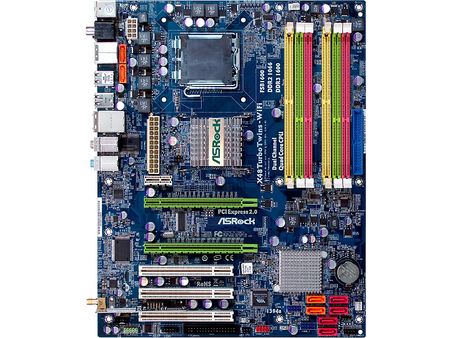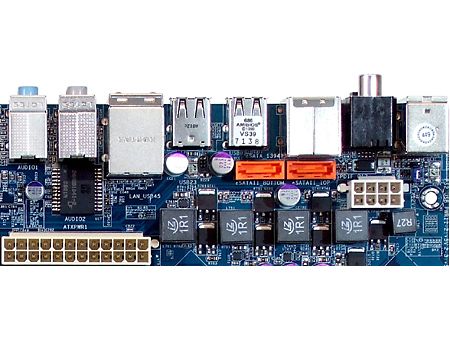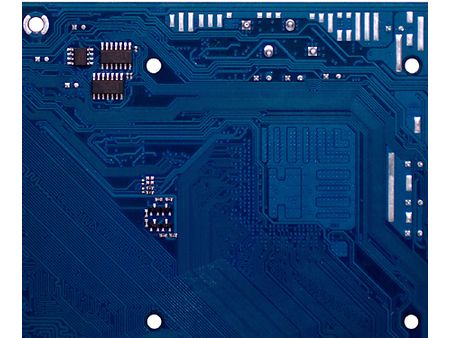X48 Motherboard Comparison, Part 2
ASRock X48TurboTwins-WiFi
With so much of ASRock’s focus being on high-value performance, few of us expected the company to use Intel’s latest high-end chipset which, after all, is more expensive but electronically identical to the earlier X38 Express. Yet, the company leapt past the earlier enthusiast part, its X48TurboTwins-WiFi, with the likely intention to entice buyers across its entire product line by producing a flagship model. Will its highest-end product to date impress us enough to have the desired brand-boosting effect?
Layout and Features
Two things that stand out about the X48TurboTwins-WiFi more than its odd name are the dual PCI-Express x16 slots and simplified chipset sink arrangement, both of which scream “value” compared to competing X48 models. We say “value” rather than “low cost” because it’s well known that the X48 doesn’t run hot, and that the third x16 slot found on higher-cost boards is nothing more than a version 1.0 slot with only four PCI-Express pathways.
Thus, ASRock cuts costs in places where higher-priced parts are mostly for show. We seriously doubt anyone would want to put a high-performance graphics card in a third slot that has only an eighth of the bandwidth of the other two slots, so eliminating it was an easy choice for ASRock. Whether or not the simplified chipset cooling is a similarly “zero-negative-effect” solution is answered in this article’s overclocking comparison.
The X48TurboTwins-WiFi is still packed with features, and one that stands out at the high end is its use of both DDR2 and DDR3 memory slots. A feature normally reserved for lower-cost products, enthusiasts on a middle budget can build their system today while carrying over the DDR2-800 memory from their old system, and upgrade to DDR3 whenever prices become more tolerable.
Two of the X48TurboTwins-WiFi’s more questionable design elements are the placement of its 24-pin ATX/EPS power connector and WiFi USB riser card header. By putting the main power lead between the rear panel ports and the Northbridge, ASRock forces builders to pull the cable over or around the CPU cooler. The WiFi card blocks one of only two PCI slots that would remain useable when two double-thick graphics cards are installed. Addressing either concern would have required ASRock to sacrifice other features, however, such as back-panel ports and DIMM slots.
ASRock also places the floppy cable header very inconveniently below the lowest PCI slot, which could result in a cabling nightmare for Windows XP users who want to use the chipset’s RAID or AHCI modes for SATA. Perhaps they believe users will forgo these advanced modes or use Windows Vista.
Another look at the X48TurboTwins-WiFi’s top corner reveals two Serial ATA connectors, but these are not ports. Rather, these are pass-through connections for rear-panel eSATA, and rely on internal ports located at the opposite corner of the board. We’re fairly certain that most users will not want to string cables corner-to-corner across the motherboard, so perhaps ASRock could have gotten back some of the previously-mentioned missing space by simply eliminating the fake eSATA ports.
Get Tom's Hardware's best news and in-depth reviews, straight to your inbox.
Flipping the motherboard over reveals some ICs close to the CPU socket, which could interfere with the installation of some CPU cooler support plates.
Current page: ASRock X48TurboTwins-WiFi
Prev Page Still on top, but for how long? Next Page Onboard Devices-
nihility I thought the major concern with overclocking was doing it with 4 GB or 8 GB of memory installed and with quad cores.Reply
Buying an overly expensive high end motherboard but installing a 65 nm dual core processor and just 2 GB of RAM seems a very odd combination to me. -
@niReply
Not so odd if you want to get the base foundation set up and then wait for lower prices on higher performance parts later on down the road.
A quad core (3.0 GHz x 4) chip is coming down the pike by years end and DDR3 prices are on the slide. Building an E8400 / 2 GB base machine is exactly what I did to finally migrate from my 5 year old P4 Extreme Edition / Intel 875 based rig.
That's the beauty of the X48 platform; longevity. -
The ECS offering has supposedly been out for around a month, but I can't find it for sale ANYWHERE!! can't even find a price. I used to turn my nose up at ECS products. Our company used Asus boards exclusively thinking they were a higher quality product. Evey one of our Asus boards failed within 4 years. This may be because the Chinese have studied the American business model... Make a product that is designed to either fail or need parts within a calculated period of time. ECS are much cheaper, and so far seem more stable than the Maximus Formula board we purchased recently. The Asus BIOS is for people who like to toy with settings. Unfortunately their BIOS has become complicated beyond their programmers ability too write stable code.Reply
-
Glad to see that gigabyte's board was so much more energy efficient than Asus', or any other board for that matter... especially while overclockingReply
-
Fedor Arcolyte - lol. Did you fall asleep and dream up another page of the review which had power consumption whilst overclocking? :pReply
For the record I'm using my first Gigabyte board (X38-DQ6) and overall I'm pretty happy with it, but having said that I haven't used Asus in at least 5 years. With these comparisons it often comes down to features since performance is pretty near (although the low memory speeds achieved by the Gigabyte surprised me!). -
" Intel covers all of its CPU VRM MOSFET?s with sinks. Our apologies for the alphabet soup that made up the last comment. " -> You could've gone with " Central Processing Unit Voltage Regulator Module Metal?Oxide?Semiconductor Field-Effect Transistor's " , so it's ok =)Reply
-
frodbonzi I wonder how the Asus' Rampage Formula stacks up here? It supports DDR2 or DDR3 and is part of the RoG line... X48 as well...Reply -
xanxaz asrock rocks....lol...although i'll keep my gigabyte... as i dont know where to say this, it's better say it here... your main page is eating my cpu cycles... between 25% up to 50% cpu utilization while viewing your site? please cut down in animated ads... running a c2d at 3.6 and still lags while surfing... dah... it's just your site... os is it me? i think it's the ad on the top right corner that is causing that...Reply -
wozeus I see that Newegg has ECS X48T-A for under $200. Looks like it's a great deal...going to get one.Reply




